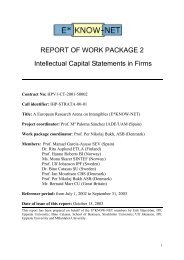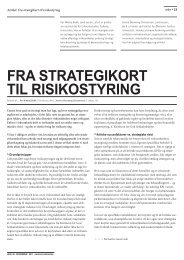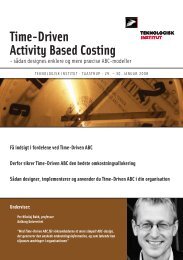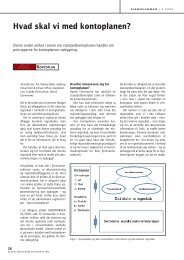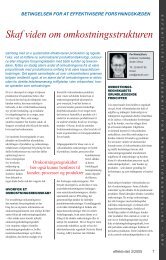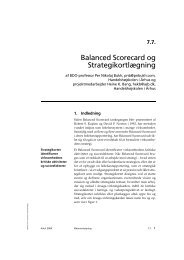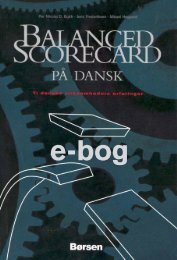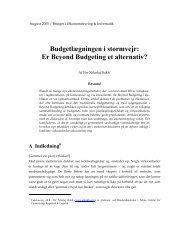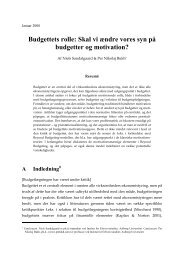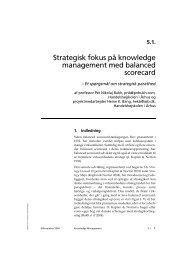guidelines for managing and reporting on intangibles (intellectual
guidelines for managing and reporting on intangibles (intellectual
guidelines for managing and reporting on intangibles (intellectual
Create successful ePaper yourself
Turn your PDF publications into a flip-book with our unique Google optimized e-Paper software.
1. Introducti<strong>on</strong><br />
It appears to be widely accepted nowadays that the world has rapidly moved from an<br />
industrial ec<strong>on</strong>omy, in which ec<strong>on</strong>omic growth was c<strong>on</strong>sidered to be mostly determined<br />
by the employment of material resources, towards a knowledge-based ec<strong>on</strong>omy in<br />
which wealth creati<strong>on</strong> is associated with the development <str<strong>on</strong>g>and</str<strong>on</strong>g> maintenance of<br />
competitive advantages based <strong>on</strong> intangible elements that are frequently grouped under<br />
the generic term knowledge.<br />
Although there is no clear <str<strong>on</strong>g>and</str<strong>on</strong>g> unique definiti<strong>on</strong> of the so-called knowledge-based or<br />
knowledge-driven ec<strong>on</strong>omy, it can be understood as the outcome of a set of structural<br />
changes. 2 First, knowledge is increasingly c<strong>on</strong>sidered as a commodity <str<strong>on</strong>g>and</str<strong>on</strong>g>, as such, is<br />
subject to ec<strong>on</strong>omic transacti<strong>on</strong>s. Sec<strong>on</strong>d, the degree of c<strong>on</strong>nectivity am<strong>on</strong>g knowledge<br />
agents has increased dramatically. Third, In<str<strong>on</strong>g>for</str<strong>on</strong>g>mati<strong>on</strong> <str<strong>on</strong>g>and</str<strong>on</strong>g> Communicati<strong>on</strong><br />
Technologies (ICT) are c<strong>on</strong>sidered as the main vehicle <str<strong>on</strong>g>for</str<strong>on</strong>g> knowledge diffusi<strong>on</strong>,<br />
facilitating the emergence <str<strong>on</strong>g>and</str<strong>on</strong>g> development of new <str<strong>on</strong>g>and</str<strong>on</strong>g> intensive global networks of<br />
knowledge agents (European Commissi<strong>on</strong> 2000a).<br />
The transiti<strong>on</strong> towards a knowledge-based ec<strong>on</strong>omy is changing the business model<br />
(Goldfinger, 1997). A closer examinati<strong>on</strong> of the multiple sources of knowledge creati<strong>on</strong><br />
undertaken within the framework of MERITUM 3 project has revealed that the<br />
knowledge <strong>on</strong> which innovating firms base their activities has become broader <str<strong>on</strong>g>and</str<strong>on</strong>g><br />
more complex. Organizati<strong>on</strong>s operating in the knowledge society are increasingly<br />
requiring str<strong>on</strong>g relati<strong>on</strong>s with their envir<strong>on</strong>ment in order to acquire <str<strong>on</strong>g>and</str<strong>on</strong>g> share essential<br />
knowledge <str<strong>on</strong>g>for</str<strong>on</strong>g> the development of their business.<br />
Since knowledge is a source of competitive advantages, firms must develop their ability<br />
to identify, measure <str<strong>on</strong>g>and</str<strong>on</strong>g> manage it. Thus, there is a need to identify both existing<br />
knowledge <str<strong>on</strong>g>and</str<strong>on</strong>g> the elements that allow or prevent its development, both at the nati<strong>on</strong>al<br />
<str<strong>on</strong>g>and</str<strong>on</strong>g> at the firm levels. The accurate measurement of the acquisiti<strong>on</strong>, producti<strong>on</strong>, <str<strong>on</strong>g>and</str<strong>on</strong>g> use<br />
of knowledge is as essential as complex. In the words of Anne Carter (1996), “when<br />
measuring knowledge we are not even wr<strong>on</strong>g". Although some attempts to measure<br />
knowledge have been made so far, both at the micro <str<strong>on</strong>g>and</str<strong>on</strong>g> the macro-ec<strong>on</strong>omic levels,<br />
there is still a l<strong>on</strong>g way to go.<br />
The err<strong>on</strong>eous measurement of knowledge, due to rapidly outdating industrial<br />
management models <str<strong>on</strong>g>and</str<strong>on</strong>g> financial <str<strong>on</strong>g>reporting</str<strong>on</strong>g> practices, may lead to an inefficient 4<br />
allocati<strong>on</strong> of material, financial <str<strong>on</strong>g>and</str<strong>on</strong>g> human resources, not <strong>on</strong>ly by firms but also by their<br />
suppliers of goods, services <str<strong>on</strong>g>and</str<strong>on</strong>g> capitals.<br />
To prevent these problems from arising in the future <str<strong>on</strong>g>and</str<strong>on</strong>g> to overcome those that could<br />
presently exist, research ef<str<strong>on</strong>g>for</str<strong>on</strong>g>ts should be devoted to improving our underst<str<strong>on</strong>g>and</str<strong>on</strong>g>ing of<br />
2 Nakamura (2001) describes some of the most significant changes in the world ec<strong>on</strong>omy over the last<br />
decade.<br />
3 See Annex 6<br />
4 We underst<str<strong>on</strong>g>and</str<strong>on</strong>g> an efficient allocati<strong>on</strong> as that which c<strong>on</strong>ducts to a maximum utility or ec<strong>on</strong>omic return<br />
(difference between the resources generated <str<strong>on</strong>g>and</str<strong>on</strong>g> the investment made) <str<strong>on</strong>g>for</str<strong>on</strong>g> a given level of risk, or as that<br />
which minimizes the agent’s risk <str<strong>on</strong>g>for</str<strong>on</strong>g> a given ec<strong>on</strong>omic return.<br />
5



